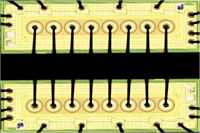MCM - Multiple-Chip-Module (Ceramic)
Bare die use in ceramic MCMs is in the majority much lower volume usage per product than plastic MCMs or SiPs. The difference in volume is predominantly related to the higher material cost of the ceramic package which for the most part excludes price sensitive volume markets such as consumer communications, smart-phones etc. There are exceptions where there is volume use in ceramic and where the mechanical properties of a ceramic MCM are a requirement for that given application, for example in some automotive or specific microwave applications.
Key benefits:
- Temperature & Mechanical Reliability
- Form factor
- Performance
- Availability
Temperature & Mechanical Reliability
The main advantage of using bare die in ceramic MCM is the temperature range capability and mechanical reliability of the package.
A bare die in a ceramic MCM can be exposed to extreme temperature ranges of -40°C to 125°C for Automotive, -55°C to +125°C for military, and -55°C to +>175°C for some oil & gas platforms without the package deteriorating and causing reliability issues.
This places emphasis on the bare die performance itself, which can be allowed to operate much closer to it's maximum working junction potential and also operational behavior at lower temperatures can be tested.
Most silicon ICs are capable of working to some degree over and above their temperature specification in single-chip commercial plastic packag (performances do vary depending on the device and temperature requirements). Additionally a key driver is the desire to prolong a components operating lifespan, where heat is a primary contributor to early failure.
High temperature contributors to failure:
- Ambient environment - E.g. Down-hole
- Bare die itself - E.g. Power amplifier or Digital Processor
- Both of the above in combination.
Bare die in MCMs can improve the device's operational lifespan by enabling better thermal management by a combination of package design and improved thermal dissipation via the package material itself.
Cold temperature contributors to failure:
- Timing deterioration in digital products
- Unanticipated change in AC performances.
Ceramic MCMs can be qualified at cold temperatures to understand performance behavior and ensure is compatible with rest of the system at that temperature.
Form factor
Ceramic MCM packages are expensive and compared with plastic so form factor/integration is usually a combination driver with the need for good thermal management and reliability. Where all devices must be ceramic packaged whether single chip or otherwise, then an MCM can provide a significant size reduction possibility at a modular level. Addtionally an MCM may be the only way to make the module if the components needed are not available as single-chip ceramic packages.
Where an entire system needs smallest form factor and temperature reliability please see the bare for use in hybrids section.
Performance
Heat management advantages - Particularly for heat generative bare die and can allow different technology die to be integrated in a small area
Signaling improvements - Not as high as plastic MCM or SiP but path lengths will still be shorter than a single chip layout, resulting in lower inductance, less parasitics
Availabilty
Most ICs are not produced by the ODM in a ceramic package, so in some cases the only alternative is to use bare die to develop either custom built single-chip ceramic package, an MCM or a hybrid circuit using bare die. An MCM concept could integrate modular functions into one package using bare die. Whereas a hybrid circuit could integrate all of the functions into one monolithic system substrate.
Ceramic MCM Versus Single Package
Ceramic MCM pros:
- Reliable under extreme environmental temperature and bare die generated temperature
- Enables improved use and combination of bare die which generate temperature
- Smaller X-Y profile than individually assembled ceramic components
- Electrical performances improves based on increased component proximity
- Modular usage across multiple applications can assist investment payback.
Ceramic MCM cons:
- Customised packages have long leadtimes and high tooling costs
- Available "standard" MCM packages may not offer right internal/external footprint
- At low volumes does not fit with standard SiP or Plastic MCM assembly lines
- Requires viable access to each bare die at low volumes
- Design reliant on consistency of bare die supply.
Single Package pros:
- Ease of availability
- Pre-qualified, characterised temperature performances
- Substrate footprint not effected by die geometry changes.
Single Package cons:
- Largest X-Y footprint
- Each individual component must be qualified in the system
- Lower performance potential in combination with other components.
Ceramic MCM Benefits in summary
Using bare die to create a ceramic MCM can enable a modular function with high reliability, great temperature performance and a form factor smaller than the single package equivalent. Particular for high power devices which generate a lot of heat a ceramic MCM can enable closer integration with other bare die. Where temperature + reliability is the key driver, the decision of whether to build MCMs or complete system hybrids is usually based on the application and commercial drivers such as usage of the functionality in other applications. The availability of bare die is key to enabling any assembly for a high reliability applications.


